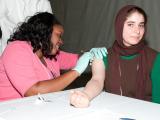Mar 8, 2013 (CIDRAP News) – Influenza activity in the United States continued to tumble last week, with one key marker—clinic visits for flulike illness—nearly approaching the national baseline, the US Centers for Disease Control and Prevention (CDC) said today.
That flu marker fell from 2.7% to 2.3% last week, putting the level within striking distance of the national baseline of 2.2%. Three of the CDC's nine regions have returned to their baselines for that measure.
The percentage of respiratory specimens that tested positive for flu rose slightly last week, from 16.9% to 17.2%
The late-season decline in overall activity, though, was accompanied by a further surge in the dominance of influenza B, which grew from 53% to 64% of the circulating strains last week.
The H3N2 strain was most common through most of the season, and the late-season spike in influenza B is a pattern health officials have seen before. Influenza B infectious can be more serious in children and can cause substantial illness in adults.
Flu-related hospitalizations rose last week from 36.7 to 38.5 per 100,000 population. The most affected group is still seniors, who account for 51% of the hospitalizations.
Six more pediatric flu deaths were reported, raising the total for this season to 87. All but one occurred during earlier weeks. Three of the deaths were from H3N2, one was from an unsubtyped influenza A virus, and two were from influenza B.
The overall percentage of deaths from pneumonia and flu fell from 7.7% to 8.4% last week, putting the level closer to the epidemic threshold of 7.5%.
Geographic spread of the disease continued to shrink last week, with only 9 states reporting widespread levels, compared with 12 the previous week.
The Pan American Health Organization (PAHO) said yesterday that flu in both the United States and Canada continued to decrease and that both countries are reporting increased influenza B detections and the highest flu hospitalization rates in seniors. It also said respiratory syncytial virus infections were stable or decreasing in both countries.
Meanwhile, flu is still having a significant impact in Europe, though levels are continuing to decline since peaking about 5 weeks ago. In its weekly update today, the European Centre for Disease Prevention and Control (ECDC) said the percentage of respiratory specimens that tested positive for flu last week was still high at 54%.
So far Europe isn't seeing the same surge in influenza B as Canada and the United States. Sentinel lab testing shows an even split between influenza A and influenza B viruses, with a greater percentage of H1N1 viruses compared with North America. The ECDC added that H1N1 detections, which started to increase early in the new year, have remained stable for the last 2 weeks.
Eighteen countries reported decreasing flu trends, including five for the first time this season: Bulgaria, Germany, Hungary, Latvia, and Romania. The only countries reporting increasing flu activity were Finland and Poland.
Testing for antiviral susceptibility found two 2009 H1N1 viruses that have the H275Y substitution linked to oseltamivir (Tamiflu) resistance, raising the total this season to 4 of 664 viruses tested. Two of the resistant viruses were from immunocompromised patients who were treated with oseltamivir, and two were in patients who didn't receive the drug.
Analysis also identified an H3N2 virus from Sweden with a D151N substitution linked to oseltamivir and zanamivir (Relenza) resistance. Tests also detected one influenza B virus that showed increased resistance to oseltamivir in a young outpatient who hadn't received the drug.
See also:
Mar 8 CDC flu surveillance report
Mar 7 PAHO flu surveillance report
Mar 8 ECDC flu surveillance overview


















